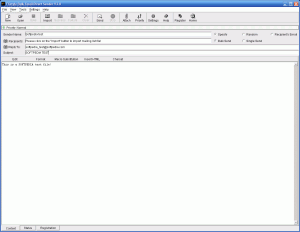Ease *****
Overview
This lesson is a basic introduction to learners on using the internet appropriately. Some of the issues and processes have been simplified to aid understanding, but the general scenarios are accurate and realistic. Learners are exposed to the possible consequences of inappropriate behaviour whilst using the internet.
Description
Read the following scenario to learners:
Carla is 13 years old. She’d had a bad day in school yesterday, she and her friends had argued with some other girls in school. The other girls had made fun of the clothes Carla had worn to the school disco. One girl in particular had been very cruel to Carla. So when she got home, she set up a new email account and sent a very nasty email to the girls that had made fun of her. Today, she is regretting her action. What should Carla do?
Group learners and tell them they have to decide what Carla should do from the following 3 options. They may only choose 1!
A) Confess. Tell the girls, the teachers and/or her parents what she’s done.
B) Go home tonight and send ANOTHER email to the girls apologising for her first email.
C) Nothing. She set up a new email account after all, so no-one in the world will know she’d sent it.
Work through the first option quickly. Discuss the possible consequences, Carla may be punished, but the fact she confessed straight away IS likely to be taken into consideration by the school and her parents. If you wish, pupils could mind-map their ideas.
Move on to the second scenario. Ask learners what they think could happen. This option can lead to the consequences as outlined for A (above) or C (below). For now focus learners’ attention on the premise that the girls either tell the teachers in school (so the result would be similar to A) or that they retaliate by sending abusive emails back to the sender. Discuss the idea of retaliation and where that could lead Carla AND the other girls.
For those that chose option C (and if no group chose this option, tell them that you’d like to take it to its logical conclusion, just out of curiosity!)read the second part of the scenario:
The same evening that Carla sent the nasty email Amy, one of girls that had received it, became quite frightened. She didn’t know who’d sent the email and was worried that it could be a stranger, the email was very personal and very cruel, but there were no clues in the email as to who had sent it. She decided to tell her parents about it.
Ask pupils what they think could happen now. Some may know exactly what will happen, but don’t reject or confirm any ideas yet. Just let everyone throw their ideas into the pot. If you want to be particularly creative, you could spend the remainder of the lesson asking groups to write the final part of the scenario themselves before sharing their ideas with the class. You can then read the choise of final scenarios in the next lesson if this is the case. Otherwise, discuss the ideas briefly before distributing the 3 scenario conclusions below to every group and ask them to either read them independently, or ask volunteers to take turns in reading aloud.
Scenario 1: having told her parents, Amy’s Mother contacted the school. Someone at the school told Amy’s mother how she could find out who’d sent the email. So, Amy’s mother logged into Amy’s inbox and highlighted the email. She right-clicked the email and selected PRIORITIES. She then clicked on the bookmark DETAILS which brought up a whole lot of writing. Amy’s mother grabbed a pencil and wrote down a long number called X-originating-IP. She then went to the website www.ip-adress.com/whois/ . This website told Amy’s Mother that the ISP was owned by BT. Amy’s mum sent the email to BT and informed them of what had happened. Now, most ISPs do not take kindly to users sending such messages whilst using their services as this can leave them open to legal procedures even though they haven´t sent the message. The company were able to find out who was logged on and using this IP address at the time that the email was sent. Nearly all ISP keep records of who is logged on and which IP address they have at the time they were using their service. BT contacted Carla’s parents. BT informed Carla’s parents that had this not been the first time (or if it were to happen again) they would contact the police. Carla’s parents were told the school knew about the email. Carla’s parents had to go for a meeting with the headteacher.
Scenario 2: Now, Amy’s Mother wasn’t an expert in computers, but after a quick search of the web she knew exactly what to do! She logged into Amy’s inbox, highlighted the email. She right-clicked on the nasty email and selected PRIORITIES. She then clicked on the bookmark DETAILS which brought up a whole lot of writing. Amy’s mother grabbed a pencil and wrote down a long number called X-originating-IP. She then went to the website www.ip-adress.com/whois/ . This website told Amy’s Mother that the ISP is owned by BT. Amy’s mum sent the email to BT and informed them of what had happened. Most ISPs do not like users sending such messages whilst using their services. BT were able to find out who was logged on and using this IP address at the time that the email was sent. BT contacted Carla’s parents. BT informed Carla’s parents that had this not been the first time (or if it were to happen again) they would contact the police. Carla’s parents had to contact the school and Amy’s parents.
Scenario 3: Amy’s Mother was horrified, so she phoned the police. A very nice person on the helpline told Amy’s mum how she could discover who’d sent the email. So, Amy’s mother logged into Amy’s inbox and highlighted the email. She right-clicked the email and selected PRIORITIES. She then clicked on the bookmark DETAILS which brought up a whole lot of writing. Amy’s mother grabbed a pencil and wrote down a long number called X-originating-IP. She then went to the website www.ip-adress.com/whois/ . This website told Amy’s Mother that the ISP was owned by BT. Amy’s mum sent the email to BT and informed them of what had happened. BT were able to find out who was logged on and using this IP address at the time that the email was sent. BT contacted Carla’s parents and told them the police had had been informed. The police visited Carla’s home.
Having done this, you can discuss the obvious, that all scenarios lead to the same basic conclusion – Carla is found out! Remember to state that these scenarios ARE more than possible, one of them is LIKELY, and that there is no way to escape being traced via your ISP. Explain that the process would be similar for tracing online abuse in whatever online medium it occurred e.g. on chat rooms, blogs etc. Discuss what the consequences might be for Carla now. Ask learners how this information will affect the way they use the internet in future. Clarify anything that learners remain unsure about and/or play the online Millionaire for Schools quiz below.
What do I need?
The scenarios on cards, a set per group. Interactive whiteboard if you wish to display the scenario text as you or the learners read it.
http://www.millionaireforschools.co.uk/quizzes/956-Age-5-7-Teacher-Support-Content-Contact-Culture/play
Hints and tips
A great way to end this unit would be to ask learners to do what Amy’s mum did and find the ISP number via email.
Find a great video here.
This post is also available in: Romanian





 English
English Nederlands
Nederlands Deutsch
Deutsch Italiano
Italiano Español
Español Português
Português Română
Română Cymraeg
Cymraeg
Can’t seem to find the millionaire for schools game anymore… which is a real nuisance! Sorry about that. Will let you know if I find something else suitable.
Internet trolls are big news in the UK at the moment. Young people posting very foolish things on twitter et al. We have to start teaching our youngsters how to behave responsibly on the net. Anyone got any ideas? Software and lessons they use already? Let us know…
Love this https://www.youtube.com/watch?v=UYxpX3N20qU